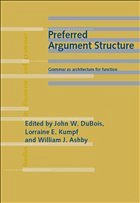Nicht lieferbar

Preferred Argument Structure
Grammar as architecture for function
Versandkostenfrei!
Nicht lieferbar
Main description:Preferred Argument Structure offers a profound insight into the relationship between language use and grammatical structure. In his original publication on Preferred Argument Structure, Du Bois (1987) demonstrated the power of this perspective by using it to explain the origins of ergativity and ergative marking systems. Since this work, the general applicability of Preferred Argument Structure has been demonstrated in studies of language after language. In this collection, the authors move beyond verifying Preferred Argument Structure as a property of a given language. They u...
Main description:
Preferred Argument Structure offers a profound insight into the relationship between language use and grammatical structure. In his original publication on Preferred Argument Structure, Du Bois (1987) demonstrated the power of this perspective by using it to explain the origins of ergativity and ergative marking systems. Since this work, the general applicability of Preferred Argument Structure has been demonstrated in studies of language after language. In this collection, the authors move beyond verifying Preferred Argument Structure as a property of a given language. They use the methodology to reveal more subtle aspects of the patterns, for example, to look across languages, diachronically or synchronically, to examine particular grammatical relations, and to examine special populations or particular genres. This volume will appeal to linguists interested in the relationship of pragmatics and grammar generally, in the typology of grammatical relations, and in explanations derived from data- and corpus-based approaches to analysis.
Table of contents:
- Preface
- Abbreviations
- Introduction
- Argument structure
- Preferred Argument Structure across time and space
- The lexicon in interaction
- Genre and Preferred Argument Structure
- Issues in the comparative argument structure analysis in Mayan narratives
- New light on information pressure
- Beyond Preferred Argument Structure
- Multiple constraints on reference form
- Argument splits in Finnish grammar and discourse
- Core arguments and the inversion of the nominal hierarchy in Roviana
- Preferred Argument Structure in early Inuktitut spontaneous speech data
- The role of Preferred Argument Structure for understanding aphasic sentence planning
- Nominal information flow in the talk of two boys with autism
- Tracking the deer
- Narrator virtuosity and the strategic exploitation of Preferred Argument Structure in Mocho
- Preferred Argument Structure Bibliography
- Name index
- Language index
- Subject index
Preferred Argument Structure offers a profound insight into the relationship between language use and grammatical structure. In his original publication on Preferred Argument Structure, Du Bois (1987) demonstrated the power of this perspective by using it to explain the origins of ergativity and ergative marking systems. Since this work, the general applicability of Preferred Argument Structure has been demonstrated in studies of language after language. In this collection, the authors move beyond verifying Preferred Argument Structure as a property of a given language. They use the methodology to reveal more subtle aspects of the patterns, for example, to look across languages, diachronically or synchronically, to examine particular grammatical relations, and to examine special populations or particular genres. This volume will appeal to linguists interested in the relationship of pragmatics and grammar generally, in the typology of grammatical relations, and in explanations derived from data- and corpus-based approaches to analysis.
Table of contents:
- Preface
- Abbreviations
- Introduction
- Argument structure
- Preferred Argument Structure across time and space
- The lexicon in interaction
- Genre and Preferred Argument Structure
- Issues in the comparative argument structure analysis in Mayan narratives
- New light on information pressure
- Beyond Preferred Argument Structure
- Multiple constraints on reference form
- Argument splits in Finnish grammar and discourse
- Core arguments and the inversion of the nominal hierarchy in Roviana
- Preferred Argument Structure in early Inuktitut spontaneous speech data
- The role of Preferred Argument Structure for understanding aphasic sentence planning
- Nominal information flow in the talk of two boys with autism
- Tracking the deer
- Narrator virtuosity and the strategic exploitation of Preferred Argument Structure in Mocho
- Preferred Argument Structure Bibliography
- Name index
- Language index
- Subject index




